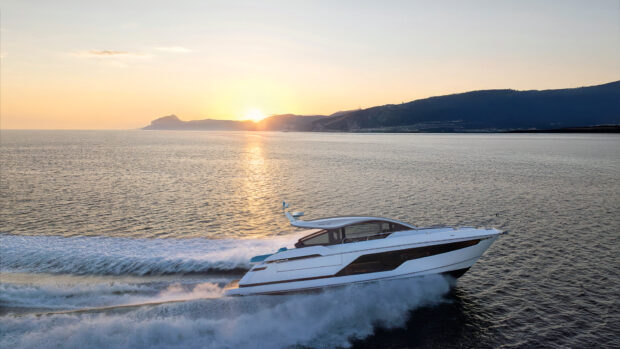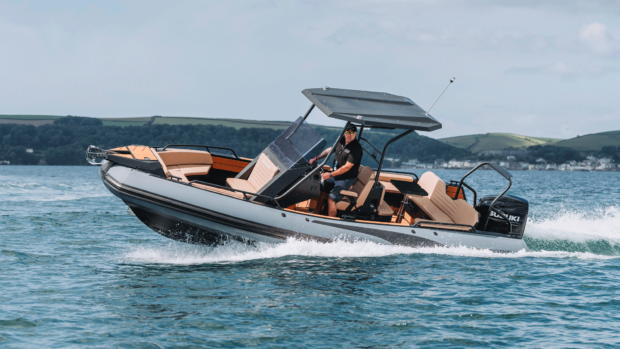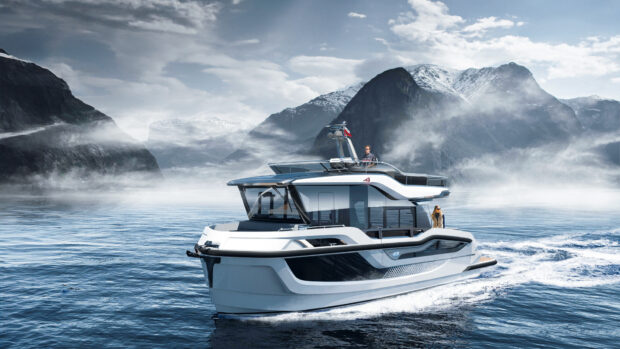Scott and Mary race against the weather in the poorly charted territories of the Chilean caletas
Caleta Brecknock , Chile
Scott and Mary Flanders left Gibraltar on 16 September 2006, and we’ll be following their journey every step of the way, thanks to this unique online “blog”. For a complete list of all the couple’s blog entries click here
Scott and Mary race against the weather in the poorly charted territories of the Chilean caletas
Tuesday 11 December
After a full day and night of rain yesterday, Egret departed Caleta Emilita at 0550 this morning. The late night grib (weather) files show a bit of wind this morning, calming later in the afternoon before slamming early tomorrow morning. Today’s run is an attempt to reach one of the most famous caletas in the southern area and hopefully we’ll make it. If not we’ll stop 25 miles short at our back up anchorage.
Our departure routine from the enclosed caletas is to recover the appropriate (leeward) shoreline then the windward, tie the dinghy close to the boat (so we don’t suck the towline into the prop), raise the anchor (with Mary rinsing the chain and removing any kelp) and then motor into a safe area so we can drift to lift the dink and secure it on the boat deck. This is all a logical progression usually without drama, unless there is a lot of wind from the wrong direction and then it gets exciting.
So far this morning (0800) the wind hasn’t exceeded 27 knots and is averaging around 18. There is a bit of chop and also so far, (a cautious so far), we haven’t found the poor charting to be an issue. Navigation has been straightforward and we have switched between using the radar, paper charts (DMA charts have proven the best so far) and the world map charting on C-Map charts, Max Sea navigation software. Today’s run, depending on which anchorage we choose, is likely to get more complicated with tight navigation between numerous small islands. The magnetic compass is 16 degrees so we don’t use it much for reference.
I would like to remind other boaters that for every given cruising area you need to obtain as much information such as cruising guides as possible. For this particular area (the southern Chilean archipelago Puerto Montt to Ushuaia, east to the Atlantic, then north to Mar del Plata, Argentina) we use the Patagonia & Tierra del Fuego Nautical Guide, and lots of useful magazine articles. Mary and I have also both read and re-read the excellent logs for the trip north through the Chilean Channels from N57, Ice Dancer II (available on www.nordhavn.com ).
Another important thing to remember is EPIRB registration. By rooting around on the NOAA website ( www.beaconregistration.noaa.gov ) I found a phone number for EPIRB registration and a real human answered the phone who couldn’t have been more helpful listing Egret’s rough itinerary in the computer. Tel 301 817-4515, toll free 888 212-7283 (from UK dial 001 first).
OK, back to wave bashing. From 1000 to 1400 we had steady winds of about 30 knots topping out at 38.8 in the Canal Ballenero. Canal Ballenero is not so much a canal as a large, narrow bay open to the Southern Ocean with little diversion for the wind. These winds mixed with tide made for TT waves (tall & tight). We increased speed from 1350rpm to 1500rpm to keep the bow from dropping so much and later increased this to 1600rpm. Our speed ranged from 3.8 to 5.5 knots including the increased rpm. We had lots of time to look at the scrubby, stunted vegetation along the way and it looks like tree hell. It seems that if you have been a very bad tree, this is where you get sent – the land of perpetual wind, rain, snow and little sun.
In due time we passed our first acceptable anchorage, however it was still early enough and with the prediction of decreasing winds and the long summer days we decided to push on (there is usable light from 05:00 to 22:30 local time). This particular area is the most demanding navigation we have experienced to date, however, using our different aids to navigate we managed to do it without too many problems (necessity is the mother of invention)!
Our optimum anchorage for this section is Caleta Brecknock, one of the most historical anchorages in this area. Going for it, we passed our second choice and pushed on for Brecknock encouraged by a favourable tide.
Before leaving Ushuaia, both our New Zealand friends on ‘Vision’ and the American/Italian couple aboard ‘On Vera’ instructed us to keep an eye out for ‘Red Sails Edward’, a 73-year-old single hander from New Zealand (I believe) in his 28ft simple sailboat. Both couples had met Edward in Puerto Montt, Chile while they were staying there. Edward has been sailing the world single-handedly for years with no engine and basically, no nothing. The Chilean Armada in Puerto Montt wouldn’t give Edward his zarpe for the Channels without an engine, with very good reason. Eventually old Red Sails caved and bought a 4hp, 4-stroke outboard. Next he built a simple bracket on the transom to mount the little engine, however he mounted it too high and ended up with a 4hp, gasoline powered fan. His friends on Vision got things straightened out and off Red Sails went. The other two boats passed him and have been in Ushuaia for weeks.
Several miles before the turn-off for Caleta Brecknock Mary spotted Red Sails Edward in the distance and hailed him on the VHF. Minimalist sailboaters don’t tend to leave their VHFs on to conserve battery power, so there was no reply. As we closed we drove over near Edward, who now hailed Egret as a ‘sport fishing boat’. Edward was exactly as described; sitting outside in the cockpit in bright yellow foul-weather gear (it was raining hard at the time and blowing over 30) towing his three-piece nesting dinghy (three pieces fit inside each other for storage on deck and are assembled for use) trailing knotted lines behind the dink. Edward doesn’t believe in lifelines so he tows the dink and knotted ropes behind. He once fell overboard and this arrangement saved him. He said, “If I’d had lifelines I wouldn’t have been able to get onboard”.
We would have loved for Edward to join us in Brecknock but it was not to be. For him to beat back against the wind and tide he was riding would have been a many hour affair, even for the relatively short distance, plus it was around 19:30. We said our goodbyes and later, at his request, e-mailed Vision his position.
We have met a number of ‘red sails’ on our travels. This small group of older adventurous sailboaters tend to take their time travelling, have been everywhere and are readily assimilated into the more ‘youthful’ liveaboard cruising community. This group suffers unimaginably and we respect their independence and toughness. Their reward for their suffering is the genuine warmth and acceptance as peers of this small, mobile cruising community. Here, age is treated with a certain respect.
Mary has spoiled a number of red sails by inviting them for dinner aboard Egret, exchanging books (as a group they tend to be big readers) while fussing over them and they seem to relish the attention.
Entering Caleta Brecknock was a chore. Brecknock is a two-mile long narrow fjord running SW/NE into Peninsula Brecknock. There are two indentations (bays) before entering the narrows and we had to navigate this with blowing rain, lots of wind and no charting of any consequence. We kept the faith moving past an anchorage (second indentation) that appeared to be exactly as described in our guide right down to the waterfall. Faith required us to go through a 60ft wide opening between two vertical rock cliffs where we couldn’t see what was beyond from under the flybridge top. Bumping in and out of gear very slowly the narrow channel soon opened into a smallish, circular bay with another waterfall and anchorage as described in the guide. I was still not totally convinced when Mary raced to the flybridge with pictures of the Caleta she found in the guide. The high rock dome we could see in the picture and ahead convinced us this was the spot.
Holding isn’t the greatest and is a bit rocky so we weren’t comfortable until the wind swung to the usual westerlies. As a precaution we moved the dink to the port side and we dropped all our fenders in the water effectively making us a floating cushion. The water is deep next to the steep-to shore so in case TK can’t grab notches in the rock we have a back up, if the wind swings to the NE and we drag.
Wednesday 12 December
Gusting westerlies, rain from time to time and the small part of the bay open to the wind through the narrow opening is churned white. Our job for the day, or next time there is no rain, is to empty the 100g fuel bladder in the cockpit. Deck fuel comes at a price and that expense is accentuated pitching with the extra weight on the ends (of the boat). The cockpit weight is the worst being so far back (the 150 gal foredeck bladder isn’t so bad because it is moved back as far as possible). With the problems of fuelling in Ushuaia, and not wanting to take a chance on spilling any fuel the foredeck bladder isn’t full, which is creating a big problem. Now it sloshes back and forth as we pitch, compounding the pitching. We’ll fill our empty jerry jugs from the cockpit bladder with an electric pump and then take the jugs forward and pump the bladder full. Next we’ll evenly divide the fuel between the main tanks and any remaining fuel will be pumped into the jerry jugs.
We plan to stay in Caleta Brecknock and explore this smallish stone coliseum. According to the guide, “it is a wonderful place to hike. A sparkling emerald lake lies just 10 minutes walk away from the anchorage, which has created the waterfall in the NE corner”. We can’t wait.










